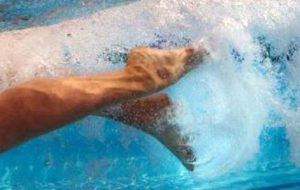 I am going to start by making what many will consider to be a controversial statement. You are not looking to get much, if ANY propulsion from your kick. Even the most elite freestyle swimmers – Michael Phelps or Ryan Lochte, to name a couple World Record holders – get less than 10% of their forward propulsion from their kick efforts; and that is at what can be considered a sprint distance (100M, 200M). In a triathlon, even at the shortest race length, you are swimming a considerably longer distance.
I am going to start by making what many will consider to be a controversial statement. You are not looking to get much, if ANY propulsion from your kick. Even the most elite freestyle swimmers – Michael Phelps or Ryan Lochte, to name a couple World Record holders – get less than 10% of their forward propulsion from their kick efforts; and that is at what can be considered a sprint distance (100M, 200M). In a triathlon, even at the shortest race length, you are swimming a considerably longer distance.
The vast majority of beginner swimmers and triathletes gain next to NO propulsion from their leg kick. Accept it and move past it!
So if my kick isn’t to help me move forward, what is it for?
An effective kick is about more than propulsion –
- Your kick should help drive body rotation, not HINDER it
- A good kick will help to achieve proper body position by lifting your legs up
- A good kick creates proper balance in the water
- A good kick will help eliminate drag
- Your kick should be EXTREMELY low effort so it minimizes energy expenditure
Most triathletes I have worked with have poor, ineffective kick technique. Working to improve your kick technique will help to increase your speed and lower your swim splits by reducing your drag through the water and improving your overall stoke efficiency.
How do I develop an effective kick?
Kick from the hip
The majority of beginner swimmers and most triathletes kick from the knee. This creates large amounts of drag and is probably the number one reason for a swimmer’s legs to sink low in the water. Try kicking ‘from the hip’ with a relatively straight leg instead of kicking from the knee.
Triathletes that were not “swimmers first” have a genuine challenge with this. Cyclists and runners learn to develop power from the knee and it’s easy to carry this habit into the water. When you bend your knee, your thigh becomes a parachute that inhibits forward motion through the water.
Proper body rotation
Having proper body rotation promotes proper kick technique –
- Good body rotation helps to keep legs from dropping
- Good body rotation helps to improve kick timing
- Proper rotation naturally helps to reduce ‘kicking-from-the-knee’
Point our toes
Pointing your toes creates a more streamlined body form through the water. On the other hand, not having your toes pointed exposes the top of your foot to the flow of water, creating drag. In more dramatic cases, you can actually reverse kick and create negative propulsion!
Consciously think of pointing your toes towards the end of the pool behind you.
Keep your feet “In-Contact”
The top of one foot should never go below the bottom of the opposite foot – your feet remain “in-contact” while kicking.
Improve ankle flexibility
Improving your ankle flexibility can have a dramatic impact upon your swim splits by reducing the amount of drag created by your legs.
In my opinion, stretching exercises will produce more results, more quickly, than any other method.
Basic Ankle Stretching Exercises
Start by sitting on any flat surface, and stretch your legs out in front of you – toes pointed towards the ceiling.
Now point your toes down as far as they’ll go, and hold for a second or two. Imagine trying to get your toes to touch the floor.
Now flex your ankles, and try to point the toes BACK toward your body. Repeat at least 10 times. Take it slow, and really feel the stretch in your ankles.
Now make circles with your feet. Make 10 circles in one direction…
…Then 10 circles in the other direction.
Make the circles as big as possible, really stretching the ankles.
Finally, point your toes toward the floor, and without turning your knees, try to get the soles of your feet to come together. Hold for a second, then flex the ankles and again without turning your knees, try to point the soles of your feet to the outside walls. Hold for a second, then repeat the whole exercise at least 10 times.
The key to improving ankle flexibility is working on it every day. These exercises take just a few minutes. Consistently perform the exercises and you will quickly begin to see results.
Kick timing
Most swimmers kick with the proper timing naturally. The key element of good timing is that as your hand enters the water at the beginning of the stroke, the opposite leg kicks. I believe there is entirely too much focus on the speed of the kick – 2, 4, or 6 beat kicking. If you accept the premise that there is very little propulsion to be gained from the kick, then the rate of the kick becomes irrelevant. Kick at the rate that is most comfortable and natural.
Focus on pointing your toes and kicking from the hip. Those are the aspects of the kick that are most likely to be holding you back.
A word about kickboards and fins
Over the past several years, swim fins and kickboards have become in-vogue for training. I frankly fail to understand why. I believe you can better learn the freestyle flutter kick by sitting on the first step of the pool with your legs outstretched in front of you and kicking with a straight leg then by using a kickboard. So much of freestyle is timing, and the timing of the kick is crucial to proper body roll. Using a kickboard does NOT help to develop timing or body roll. In fact, it can help to develop bad habits as the kickboard promotes NO body roll.
I hear the argument on almost a daily basis that swim fins will help to improve ankle flexibility. I will concede that may be true, however, targeted stretching exercises will improve flexibility in less time without the danger of developing bad habits. Artificially increasing your speed through the water with fins alters the catch – a very important aspect of the stroke. Additionally, the artificially increased speed alters the pull and push, again altering important aspects of the stroke. Finally I hear how fins will strengthen your ankles and legs. Perhaps; however, you can also do the same thing – more quickly – with a targeted weight program in the gym.
During the height of my swimming career I was swimming 12-15,000 meters per day, 7 days a week, 365 days a year. That works out to more than 350,000 meters per month. Not one time, in more than 20 years of competitive swimming did I put on a pair of swim fins. I don’t recall using a kickboard more than 500 meters in a month during the same time. Have times changes in the 30 years since I hung up my competitive Speedo? Undoubtedly. That said however, to date nobody has been able to present valid counter-points to my arguments against fins and kickboards.
Why are my legs sinking when I swim Freestyle?
That may be the most frequent question I am asked about swimming. Here are the most common reasons:
- Holding your breath under water – If you are holding your breath and not exhaling while you swim your chest is more buoyant. Your body acts as a balance and as your head and chest rise, your legs will drop. If your legs are sinking, working on exhaling should be your first step.
- Kicking from the knee and inflexible ankles – Both kicking from the knee and having inflexible ankles will create a great deal of drag, sinking your legs. Work on kicking from the hip with a straight leg and doing stretching exercises to increase your ankle flexibility.
- Left/Right flexion through the core – Flexing left and right through your core will cause you to ‘snake’ through the water. Additionally, because you are presenting your core to the flow of water, you are slowing yourself down, which will cause your legs to drop. Work on improving your body roll; it is nearly impossible to flex through the core if your body rotation is correct.
- Head to high in the water – Holding your head to high in the water, or breathing with your head to high, will drop your legs. Remember your body is a balance, and like a see-saw, up in front means down in back. Work on keeping your head down with your eyes looking more towards the bottom then forward.
- Improper catch at beginning of your stroke – A very common mistake among both beginning swimmers and triathletes alike occurs at the beginning of their stroke – called the ‘catch.’ A good catch presses the water backwards. On the other hand, a poor catch presses the water downwards. Remember your body’s balance and the see-saw example. Pressing water down will raise your arms and shoulders, dropping your legs.
